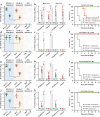A broad-spectrum vaccine candidate against H5 viruses bearing different sub-clade 2.3.4.4 HA genes
- PMID: 39160189
- PMCID: PMC11333769
- DOI: 10.1038/s41541-024-00947-4
A broad-spectrum vaccine candidate against H5 viruses bearing different sub-clade 2.3.4.4 HA genes
Abstract
The global spread of H5 clade 2.3.4.4 highly pathogenic avian influenza (HPAI) viruses threatens poultry and public health. The continuous circulation of these viruses has led to their considerable genetic and antigenic evolution, resulting in the formation of eight subclades (2.3.4.4a-h). Here, we examined the antigenic sites that determine the antigenic differences between two H5 vaccine strains, H5-Re8 (clade 2.3.4.4g) and H5-Re11 (clade 2.3.4.4h). Epitope mapping data revealed that all eight identified antigenic sites were located within two classical antigenic regions, with five sites in region A (positions 115, 120, 124, 126, and 140) and three in region B (positions 151, 156, and 185). Through antigenic cartography analysis of mutants with varying numbers of substitutions, we confirmed that a combination of mutations in these eight sites reverses the antigenicity of H5-Re11 to that of H5-Re8, and vice versa. More importantly, our analyses identified H5-Re11_Q115L/R120S/A156T (H5-Re11 + 3) as a promising candidate for a broad-spectrum vaccine, positioned centrally in the antigenic map, and offering potential universal protection against all variants within the clade 2.3.4.4. H5-Re11 + 3 serum has better cross-reactivity than sera generated with other 2.3.4.4 vaccines, and H5-Re11 + 3 vaccine provided 100% protection of chickens against antigenically drifted H5 viruses from various 2.3.4.4 antigenic groups. Our findings suggest that antigenic regions A and B are immunodominant in H5 viruses, and that antigenic cartography-guided vaccine design is a promising strategy for selecting a broad-spectrum vaccine.
© 2024. The Author(s).
Conflict of interest statement
The authors declare no competing interests.
Figures





Similar articles
-
Key Amino Acid Residues That Determine the Antigenic Properties of Highly Pathogenic H5 Influenza Viruses Bearing the Clade 2.3.4.4 Hemagglutinin Gene.Viruses. 2023 Nov 13;15(11):2249. doi: 10.3390/v15112249. Viruses. 2023. PMID: 38005926 Free PMC article.
-
Cross-Protection by Inactivated H5 Prepandemic Vaccine Seed Strains against Diverse Goose/Guangdong Lineage H5N1 Highly Pathogenic Avian Influenza Viruses.J Virol. 2020 Nov 23;94(24):e00720-20. doi: 10.1128/JVI.00720-20. Print 2020 Nov 23. J Virol. 2020. PMID: 32999029 Free PMC article.
-
Shifting Clade Distribution, Reassortment, and Emergence of New Subtypes of Highly Pathogenic Avian Influenza A(H5) Viruses Collected from Vietnamese Poultry from 2012 to 2015.J Virol. 2017 Feb 14;91(5):e01708-16. doi: 10.1128/JVI.01708-16. Print 2017 Mar 1. J Virol. 2017. PMID: 28003481 Free PMC article.
-
Potential cross-species transmission of highly pathogenic avian influenza H5 subtype (HPAI H5) viruses to humans calls for the development of H5-specific and universal influenza vaccines.Cell Discov. 2023 Jun 16;9(1):58. doi: 10.1038/s41421-023-00571-x. Cell Discov. 2023. PMID: 37328456 Free PMC article. Review.
-
The genetics of highly pathogenic avian influenza viruses of subtype H5 in Germany, 2006-2020.Transbound Emerg Dis. 2021 May;68(3):1136-1150. doi: 10.1111/tbed.13843. Epub 2020 Sep 29. Transbound Emerg Dis. 2021. PMID: 32964686 Review.
Cited by
-
Detection and characterisation of high pathogenicity avian influenza virus (H5N1/H5N8) clade 2.3.4.4b, Hong Kong SAR, China, 2021 to 2024.Euro Surveill. 2025 Jan;30(1):2400839. doi: 10.2807/1560-7917.ES.2025.30.1.2400839. Euro Surveill. 2025. PMID: 39790075 Free PMC article.
-
Computationally designed haemagglutinin with nanocage plug-and-display elicits pan-H5 influenza vaccine responses.Emerg Microbes Infect. 2025 Dec;14(1):2511132. doi: 10.1080/22221751.2025.2511132. Epub 2025 Jul 11. Emerg Microbes Infect. 2025. PMID: 40476519 Free PMC article.
-
Intranasally administered whole virion inactivated vaccine against clade 2.3.4.4b H5N1 influenza virus with optimized antigen and increased cross-protection.Virol J. 2025 May 5;22(1):131. doi: 10.1186/s12985-025-02760-4. Virol J. 2025. PMID: 40320528 Free PMC article.
-
Pandemic preparedness of effective vaccines for the outbreak of newly H5N1 highly pathogenic avian influenza virus.Virol Sin. 2024 Dec;39(6):981-985. doi: 10.1016/j.virs.2024.11.005. Epub 2024 Nov 30. Virol Sin. 2024. PMID: 39622294 Free PMC article.
-
Phylogenitc analysis and immunogenicity comparison of porcine genotype G9 rotavirus in China from 2020-2023.Virol Sin. 2025 Apr;40(2):176-185. doi: 10.1016/j.virs.2025.02.003. Epub 2025 Feb 21. Virol Sin. 2025. PMID: 39988297 Free PMC article.
References
-
- Yoon, S. W., Webby, R. J. & Webster, R. G. Evolution and ecology of influenza A viruses. Curr. Top. Microbiol. Immunol.385, 359–375 (2014). - PubMed
LinkOut - more resources
Full Text Sources
Molecular Biology Databases

